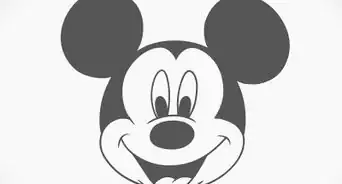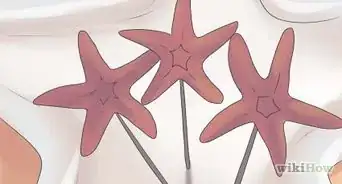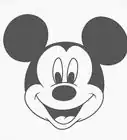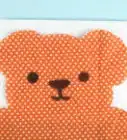This article was co-authored by wikiHow Staff. Our trained team of editors and researchers validate articles for accuracy and comprehensiveness. wikiHow's Content Management Team carefully monitors the work from our editorial staff to ensure that each article is backed by trusted research and meets our high quality standards.
There are 7 references cited in this article, which can be found at the bottom of the page.
This article has been viewed 170,094 times.
Learn more...
Mickey's sweetheart has the fashion sense to wear a bow in her ears, but Minnie mouse has very similar ears to those of her beau. In some special costumes, Minnie has also been known to wear a crown, a Santa hat, and other seasonal accents between her ears. The ears are always black, of course, and the bow usually red with white polka-dots, but you can choose your favorite patterns and colors to make the bow you place between your Minnie Mouse ears.
Steps
Making the Ears
-
1Gather the material for making your mouse ears. You will need black felt to give your mouse ears color and texture. A cardboard core will give your fabric rigidity and form. If you don't have any cardboard, you might be able to layer several pieces of rigid construction paper together with glue as a substitute. The material you use for the ears should be stiff enough to keep it from flopping around loosely once attached to the headband and if you don’t have felt, you can paint or color the cardboard black.
- Black felt
- Cardboard
- Rigid construction paper (optional)
- Household glue
- Plain paper
- Ribbon (10” (25 cm) long)
- Ribbon (3” (7 cm) long)
- You should be able to purchase everything you need for this project at your local fabric or craft store.
-
2Purchase a headband and tools, if necessary. The headband can be any color, but it should be at least ½" (1.27 cm) thick. You will eventually attach your mouse ears to the headband, so thicker headbands might give your mouse ears greater stability. Including a head band, you should also purchase the following tools:[1]
- Headband
- Hot glue gun (and glue)
- Household glue
- Pencil
- Pipe cleaner
- Scissors
Advertisement -
3Make two identical paper circle templates. You should trace two circles on your paper with a pencil or your chalk. Each circle should be between 3” and 5” (7.6 and 12.7 cm) and have a ½” (1.27 cm) tab at the bottom of the circle. These templates will be used to assist you in outlining the dimensions of your mouse ears on both fabric and cardboard.
- The tabs will on the bottom of your circles will be used to secure the ears and the headband together.
- You might be able to use the base of a bowl to help you in drawing identical circles for both of your templates.
-
4Outline your felt circles onto your felt. Place your paper template on top of the felt and trace the circle with chalk onto it. You could use a piece of tailor’s chalk, or even regular chalk in a pinch. This way, you can wipe any leftover chalk away with a damp cloth.
- Make four felt circles for every pair of ears you make. You will need to glue felt to the front and back of your cardboard core to make your mouse ears uniformly black.
-
5Cut your felt circles. Take your scissors and follow the chalk outlines you've drawn to cut free your felt circles free from the fabric.You can add some jazzy flair to your mouse ears by using zig-zaggy pinking shears.[2]
- Pinking shears will add a cute border to your fabric and prevent your fabric from becoming frayed.[3]
-
6Trace cardboard circles for your mouse ears. These cardboard circles will form the core of your mouse ears, making it possible for them stand up straight, just like Minnie's! Use your pencil or a piece of chalk to trace the circle template onto the cardboard.[4]
- You will need two cardboard circles for every pair of ears you make.
-
7Cut out your cardboard circles. Using your scissors, follow the chalk or pencil outline you drew with your templates onto the cardboard. Be sure you don't cut off your tabs! These will be necessary to connect your mouse ears to the headband.[5]
- You may need to touch up your cardboard and felt circles/tabs to make them as close to identical as possible.
- Compare and trim your felt and cardboard circles by holding the cardboard and felt pieces together in a stack. Then you can trim down any irregularities.
-
8Glue the felt to the cardboard. Household glue should be sufficient to attach a piece of felt to the front and back of each cardboard circle/ear. Drizzle glue back and forth along the cardboard and press your felt into place. Press the felt to the glue firmly for five to ten minutes help it set.
- To create the best bond between your glue and the felt, you may want to allow your glue to rest for 30 minutes to an hour.
Attaching the Ears to the Headband
-
1Spread hot glue along the tabs of the ears. Regular household glue won’t hold up to wear and tear as well as hot glue. The special glue used in hot glue guns, however, is much more durable. It will create a firm bond between ear and headband.
- You'll have to move quick after you apply your hot glue. The glue will dry quickly soon after application.
- Hot glue fresh from the gun will be very hot. Be careful not to burn yourself.[6]
-
2Hot glue the tabs of your circles to the underside of the headband. Your circles should be at least 4” (10 cm) apart so that you have room for the bow that will go between the ears. You may want to mark your headband with your chalk where you'll be attaching the ears to prevent yourself from gluing them into the wrong place.[7]
- If your headband is flexible or will permit the use of staples, you could also use a hardy stapler to connect the tabs of your mouse ears to your headband.
-
3Allow the glue to dry thoroughly. Playing with your mouse ears before the glue has completely dried could cause your mouse ears to come free of the headband. To ensure you don't have to re-glue any of your pieces together, you should allow your glue to firm for 30 minutes to an hour.
-
4Style the ears into position. Your mouse ears might not stand straight up like Minnie Mouse's at first. To encourage your mouse ears to hold this position, fold both up and forward. The glued tabs will keep the ears in place.
Creating the Bow
-
1Measure and cut a 10” (25 cm) length of ribbon or fabric. You can use either ribbon or fabric for your bow, although ribbon will likely be a little shinier and look more like the bow Minnie wears. In either case, it should be 5” to 8” (12.7 to 20.3 cm) wide. You will eventually gather this fabric around its middle, which will cause the sides to fan out. This will give your bow its shape.
-
2Measure and cut a 3” (7.6 cm) gathering string. This is the piece you will use to gather the fabric around the middle of your 10" (25 cm) length of ribbon. You should use a similar kind of fabric to your 10" (25 cm) ribbon, but you could also add some pop to your design by using a contrasting color fabric.
- For example, if you are using Minnie's traditional bow color, red with white polka-dots, you might choose a bold blue for your gathering string.
-
3Lay the 10" (25 cm) piece of ribbon on a flat surface. Put the print side face down. You're going to want to glue your gathering string along the back of your bow, which will be the same as the opposite side of the pattern.
-
4Fold the long ends your 10" (25 cm) ribbon toward its center. You'll want each side to overlap slightly at the center of your 10" (25 cm) length of ribbon. Fold one end at a time so that there is enough overlap to glue these side where the meet at the center of the ribbon.[10]
-
5Glue the folded inward ends at the overlap. It should only take a dab or two of hot glue or fabric glue to join the ends together firmly. Press the fabric firmly to create a stronger bond between the fabric and glue.
- You should follow the directions on your glue to achieve the best bond. Some glues will set and cure faster than others. Generally, you should hold the glue firmly for one to five minutes for best results.
-
6Arrange your ribbon into a bow shape. Use one hand to pinch your ribbon together toward its centermost point from the top and bottom edges. This will be easiest to do if you are working with a ribbon that is at least 5” (12.7 cm) wide.
- Pinching your ribbon together tightly will cause the outside edges to flare out more dramatically.
-
7Loosely wrap your gathering string around your bunched ribbon. The 3” (7.6 cm) piece of ribbon will hold the fabric of your bow in its flared position. Wind it around several times and then remove your fingers where you were pinching the bow in the middle.
- Hold the ribbon with your free hand to make sure it doesn't come unwound or loose.
- Wind the remaining length of your ribbon around the center tightly.
-
8Glue the gathering string in place. Lift one end of the small piece of ribbon and apply a dab of hot glue or fabric glue. If using hot glue, you should be careful not to burn yourself by pressing on the fabric immediately after glue application.
- To apply pressure to make the best seal between your hot glue and fabric, you might use a tool to prevent getting burned, like a paperweight, gloved hand, or tweezers.
- Fabric glue and other cold glues should be held together firmly to encourage a strong bond. Press the glued piece of ribbon together. Hold this position for about 30 seconds to a minute.
Attaching the Bow to the Headband
-
1Slip a pipe cleaner through a fold in your bow. The bunchings of your bow fabric should have created folds through which you can thread your pipe cleaner so that it passes under your glued gathering string.
- If you find it difficult to feed your pipe cleaner through a fold and under your gathering string, you can always use glue to attach the pipe cleaner along the back of your bow.
- A dab of hot glue onto the back of your gathering string should be enough to hold your pipe cleaner in place.
-
2Cross one end of the piper cleaner over the other. Orient your pipe cleaner so it is equal length on both sides of your gathering string. Now cross the sides of your pipe cleaner at the midpoint over the front of your gathering string and add a twist.
- This will prevent the pipe cleaner from slipping out of the bow while adding stability to the bow in general.
- Experiment with different colored pipe cleaners to personalize your Minnie Mouse ears!
-
3Secure your bow with the loose ends of the pipe cleaner. Center the bow between the ears. Then you're going to wrap each end of the pipe cleaner around opposite ends of your headband. Twine each side of the pipe cleaner down opposite ends of the headband until you go no further.
- The ends of pipe cleaner can be pointy. To prevent the wearer from getting poked, you may want to turn these inward on your headband. The ends can also be taped to the headband as an extra precaution.
- By attaching your bow to your mouse ears with a pipe cleaner, you'll be able to swap out different bows without having to make a new pair of mouse ears.
- Twist ties can be used to reinforce your pipe cleaners if you find the pipe cleaner windings are not holding the bow in place well enough.
-
4Add finishing touches and show off your mouse ears. Minnie, being a stylish mouse, would probably go ga-ga over some rhinestones, glitter, feathers, or other accents you might add to your mouse ears. Most of these can be attached with a small dab of hot glue. Once you've finished adding your finishing touches, you should show off your mouse ears to all your friends.
Community Q&A
-
QuestionThe bow with the pipe cleaner seems odd. Can I glue it instead?
 Community AnswerYes. Take the part where the fabric is wrapped around to keep the bow in place, and apply the glue to that. Take the bow and press it firmly on the headband. Apply pressure to it for about 30 seconds to a minute so it won't flop over.
Community AnswerYes. Take the part where the fabric is wrapped around to keep the bow in place, and apply the glue to that. Take the bow and press it firmly on the headband. Apply pressure to it for about 30 seconds to a minute so it won't flop over. -
QuestionCan I use any fabric?
 SylghoulsTop AnswererSure! Felt is just suggested because it is a matte fabric with some texture to it that may help you achieve the desired effect. But ultimately, you can use any black fabric you have on hand as long as you like the look of it.
SylghoulsTop AnswererSure! Felt is just suggested because it is a matte fabric with some texture to it that may help you achieve the desired effect. But ultimately, you can use any black fabric you have on hand as long as you like the look of it. -
QuestionIs this copyright infringement?
 Community AnswerNo. As long you do not sell or otherwise make a profit off of these items, it is not copyright infringement.
Community AnswerNo. As long you do not sell or otherwise make a profit off of these items, it is not copyright infringement.
Warnings
- Hot glue emerges from the gun applicator at a very high temperature. Whenever using hot glue, you should follow the instructions that came with your glue gun and take care.⧼thumbs_response⧽
Things You’ll Need
- Ribbon (10” (25 cm) long)
- Ribbon (3” (7 cm) long)
- Black felt
- Black felt tip marker, black crayon or paint (optional)
- Cardboard
- Chalk
- Foam (optional)
- Headband
- Hot glue gun
- Household glue
- Pipe cleaner
- Plain paper
- Scissors
- Stiff construction paper (optional)
References
- ↑ http://www.thesuburbanmom.com/2010/06/16/how-to-make-mickey-minnie-mouse-ears-for-a-party/
- ↑ https://www.threadsmagazine.com/2010/12/09/keep-these-seam-finishes-in-your-bag-of-tricks
- ↑ http://www.craftsy.com/blog/2013/05/seam-series-serger-and-pinking-seam-finishing/
- ↑ http://thenerdswife.com/diy-mickey-mouse-ears.html
- ↑ http://www.thesuburbanmom.com/2010/06/16/how-to-make-mickey-minnie-mouse-ears-for-a-party/
- ↑ http://www.thomasnet.com/articles/adhesives-sealants/what-are-hot-glue-guns
- ↑ http://thenerdswife.com/diy-mickey-mouse-ears.html
- ↑ http://www.save-on-crafts.com/bow2.html
- ↑ http://www.save-on-crafts.com/how-to-make-a-floral-bow.html
















































